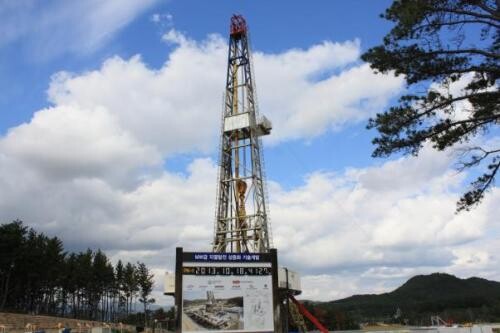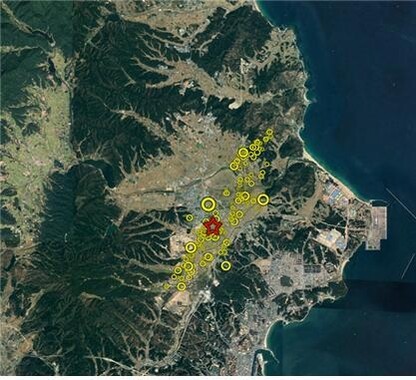hankyoreh
Links to other country sites 다른 나라 사이트 링크
Scientists discuss correlation between geothermal plant and Pohang earthquake

Geologists and seismologists at a recent forum said it is possible that the earthquake in Pohang was affected by a geothermal power plant nearby but that this will probably not be confirmed as the actual cause of the earthquake. On Nov. 24, an emergency forum on the Pohang earthquake was held at the Press Center in downtown Seoul by four academic associations in the areas of geology and seismology, including the Geological Society of Korea.
“Injecting water into the earth can reduce friction on a fault line, causing movement and potentially triggering a major earthquake in an area that is already under pressure. There have been steady reports of similar incidents overseas,” said Lee Jin-han, a professor at the department of earth and environmental science at Korea University, during the forum. A 5.6-magnitude earthquake that was triggered in Oklahoma in 2011 by water poured underground as part of petroleum and natural gas extraction is cited as one of the best examples of a human-induced earthquake.
“However, the scientific model needs a verification process. Earthquakes induced by the injection of water are more strongly correlated with the speed of injection than with the amount injected,” Lee added.

“The epicenter of the Pohang earthquake was 600 meters away from the geothermal plant. After observing microearthquakes in the area around Gyeongju since the Gyeongju earthquake, my analysis is that there is a connection between the period when the geothermal plant was pumping water into the ground from Jan. 29, 2016, to Sept. 18, 2017, and the microearthquakes that were occurring during that time,” said Kim Gwang-hui, a professor of geological and environmental sciences at Busan University.
“Considering the data that has been released thus far, it’s true that there are indications of a correlation between the Pohang earthquake and geothermal power generation. However, the amount of water that was injected and the speed of injection have not provided us with answers sufficient to resolve doubts.”
“The fact that a small amount of water was injected at the geothermal plant at Pohang and that a large number of microearthquakes had occurred previously prevent us from concluding that the Pohang earthquake occurred because of the geothermal plant,” said Hong Tae-gyeong, a professor in the department of earth system science at Yonsei University. The Pohang geothermal plant has injected a total of 12,000㎥ water on four or five occasions since 2016 and then removed some of that water, and currently about 5,000㎥ remains underground.
In Oklahoma, however, 20 million tons of water was injected into hundreds of boreholes. A region in which there had been about one earthquake with a magnitude of 3.0 or higher per year has now become one with more than 900 such earthquakes each year. Geologists also draw attention to the environmental differences: in Oklahoma, water was trapped underground, while the Pohang geothermal plant uses a system in which water is brought back to the surface through an injection of steam.
“Given the awareness that earthquakes are triggered by the development of geothermal power, measures are usually taken to prevent a major earthquake from occurring. Since the Pohang earthquake occurred two months after water was injected for the last time, it is doubtful whether geothermal power was the cause,” said Jang Chan-dong, a professor of geological and environmental science at Chungnam National University.
“Analyzing the moment tensor, which expresses the phenomena that brought about the seismic waves as a combination of forces, shows that the Pohang earthquake could have been an earthquake that occurred on a complex fault plane, unlike ordinary earthquakes. But the possibility that it was affected by high-pressure liquid appears to be low,” said Lee Jun-gi, a professor of geological and environmental science at Seoul National University.
By Lee Keun-young, senior staff writer
Please direct questions or comments to [english@hani.co.kr]

Editorial・opinion
![[Column] Park Geun-hye déjà vu in Yoon Suk-yeol [Column] Park Geun-hye déjà vu in Yoon Suk-yeol](https://flexible.img.hani.co.kr/flexible/normal/500/300/imgdb/original/2024/0424/651713945113788.jpg) [Column] Park Geun-hye déjà vu in Yoon Suk-yeol
[Column] Park Geun-hye déjà vu in Yoon Suk-yeol![[Editorial] New weight of N. Korea’s nuclear threats makes dialogue all the more urgent [Editorial] New weight of N. Korea’s nuclear threats makes dialogue all the more urgent](https://flexible.img.hani.co.kr/flexible/normal/500/300/imgdb/original/2024/0424/7317139454662664.jpg) [Editorial] New weight of N. Korea’s nuclear threats makes dialogue all the more urgent
[Editorial] New weight of N. Korea’s nuclear threats makes dialogue all the more urgent- [Guest essay] The real reason Korea’s new right wants to dub Rhee a founding father
- [Column] ‘Choson’: Is it time we start referring to N. Korea in its own terms?
- [Editorial] Japan’s rewriting of history with Korea has gone too far
- [Column] The president’s questionable capacity for dialogue
- [Column] Are chaebol firms just pizza pies for families to divvy up as they please?
- [Column] Has Korea, too, crossed the Rubicon on China?
- [Correspondent’s column] In Japan’s alliance with US, echoes of its past alliances with UK
- [Editorial] Does Yoon think the Korean public is wrong?
Most viewed articles
- 1[Column] Park Geun-hye déjà vu in Yoon Suk-yeol
- 2Thursday to mark start of resignations by senior doctors amid standoff with government
- 3N. Korean hackers breached 10 defense contractors in South for months, police say
- 4Kim Jong-un expressed ‘satisfaction’ with nuclear counterstrike drill directed at South
- 5[Editorial] New weight of N. Korea’s nuclear threats makes dialogue all the more urgent
- 6Will NewJeans end up collateral damage in internal feud at K-pop juggernaut Hybe?
- 7[Column] ‘Choson’: Is it time we start referring to N. Korea in its own terms?
- 8[Editorial] Japan’s rewriting of history with Korea has gone too far
- 9[Cine feature] A new shift in the Korean film investment and distribution market
- 10[Column] The president’s questionable capacity for dialogue